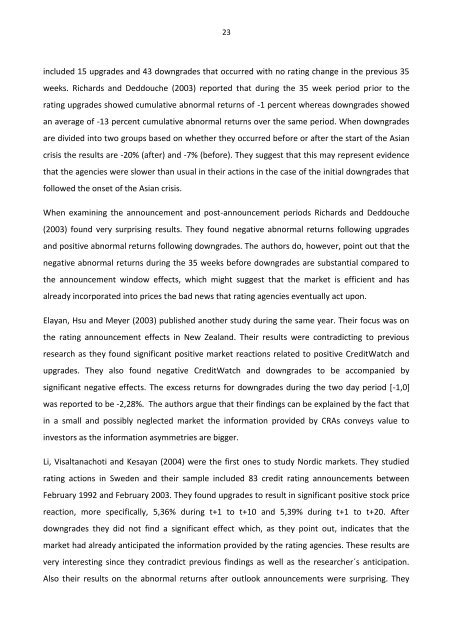Do Credit Rating Announcements Have Informational Value ...
Do Credit Rating Announcements Have Informational Value ...
Do Credit Rating Announcements Have Informational Value ...
Create successful ePaper yourself
Turn your PDF publications into a flip-book with our unique Google optimized e-Paper software.
23<br />
included 15 upgrades and 43 downgrades that occurred with no rating change in the previous 35<br />
weeks. Richards and Deddouche (2003) reported that during the 35 week period pr ior to the<br />
rating upgrades showed cumulative abnormal returns of -1 percent whereas downgrades showed<br />
an average of -13 percent cumulative abnormal returns over the same period. When downgrades<br />
are divided into two groups based on whether they occurred before or after the start of the Asian<br />
crisis the results are -20% (after) and -7% (before). They suggest that this may represent evidence<br />
that the agencies were slower than usual in their actions in the case of the initial downgrades that<br />
followed the onset of the Asian crisis.<br />
When examining the announcement and post-announcement periods Richards and Deddouche<br />
(2003) found very surprising results. They found negative abnormal returns following upgrades<br />
and positive abnormal returns following downgrades. The authors do, however, point out that the<br />
negative abnormal returns during the 35 weeks before downgrades are substantial compared to<br />
the announcement window effects, which might suggest that the market is efficient and has<br />
already incorporated into prices the bad news that rating agencies eventually act upon.<br />
Elayan, Hsu and Meyer (2003) published another study during the same year. Their focus was on<br />
the rating announcement effects in New Zealand. Their results were contradicting to previous<br />
research as they found significant positive market reactions related to positive <strong>Credit</strong>Watch and<br />
upgrades. They also found negative <strong>Credit</strong>Watch and downgrades to be accompanied by<br />
significant negative effects. The excess returns for downgrades during the two day period [-1,0]<br />
was reported to be -2,28%. The authors argue that their findings can be explained by the fact that<br />
in a small and possibly neglected market the information provided by CRAs conveys value to<br />
investors as the information asymmetries are bigger.<br />
Li, Visaltanachoti and Kesayan (2004) were the first ones to study Nordic markets. They studied<br />
rating actions in Sweden and their sample included 83 credit rating announcements between<br />
February 1992 and February 2003. They found upgrades to result in significant positive stock price<br />
reaction, more specifically, 5,36% during t+1 to t+10 and 5,39% during t+1 to t+20. After<br />
downgrades they did not find a significant effect which, as they point out, indicates that the<br />
market had already anticipated the information provided by the rating agencies. These results are<br />
very interesting since they contradict previous findings as well as the researcher´s anticipation.<br />
Also their results on the abnormal returns after outlook announcements were surprising. They















